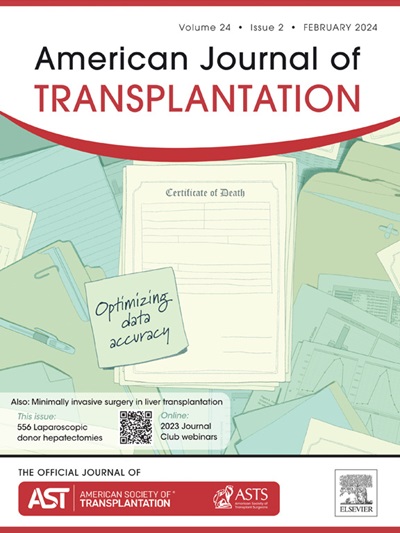Microvascular inflammation in kidney allografts: New directions for patient management
IF 8.9
2区 医学
Q1 SURGERY
引用次数: 0
Abstract
Microvascular inflammation (MVI) is a key histological feature of immune-mediated injury at the capillary interface of renal allografts, characterized by immune cell infiltration into glomerular and peritubular capillaries. Although traditionally associated with antibody-mediated rejection (AMR), many MVI cases lack detectable donor-specific antibodies (DSA), suggesting the involvement of antibody-independent immune mechanisms or alternative triggers, such as viral infections or ischemia-reperfusion injury. The Banff 2022 scheme introduced a subcategory, “MVI, DSA-negative, C4d-negative,” within an overarching AMR or MVI category. This subcategory—similar to AMR—was shown to carry a significant risk of graft failure. Its recognition marks a major advancement, offering a robust framework for investigating the pathophysiology of MVI, which may involve a wide array of overlapping triggers. Emerging evidence from transcriptome analyses highlights natural killer cells as possible effectors, regardless of DSA status. Therapies targeting natural killer cells, particularly the anti-CD38 antibody felzartamab, have shown promising reductions in MVI and molecular injury. Notably, the US Food and Drug Administration has approved an MVI-based primary endpoint for a phase 3 trial evaluating this approach, representing a critical step toward the development of new therapeutics. Recognizing MVI as a multifaceted histological phenotype—driven by diverse triggers—may signal a paradigm shift in transplant medicine.
同种异体肾移植的微血管炎症:患者管理的新方向。
微血管炎症(MVI)是同种异体移植肾毛细血管界面免疫介导损伤的一个关键组织学特征,其特征是免疫细胞浸润到肾小球和小管周围毛细血管。虽然传统上与抗体介导的排斥反应(AMR)有关,但许多MVI病例缺乏可检测的供体特异性抗体(DSA),这表明涉及抗体独立的免疫机制或其他触发因素,如病毒感染或缺血再灌注损伤。班夫2022方案在总体AMR/MVI类别中引入了一个子类别,“MVI, dsa阴性,c4d阴性”。与AMR相似,这一亚型具有显著的移植物衰竭风险。它的识别标志着一个重大的进步,为研究MVI的病理生理学提供了一个强有力的框架,MVI可能涉及一系列重叠的触发因素。来自转录组分析的新证据强调自然杀伤细胞(NK细胞)可能是效应器,无论DSA状态如何。针对NK细胞的治疗,特别是抗cd38抗体非扎他单,已经显示出有希望减少MVI和分子损伤。值得注意的是,美国食品和药物管理局已经批准了一个基于mvi的主要终点,用于评估该方法的3期试验,这代表着新疗法发展的关键一步。认识到MVI是由多种触发因素驱动的多方面组织学表型-可能标志着移植医学范式的转变。
本文章由计算机程序翻译,如有差异,请以英文原文为准。
求助全文
约1分钟内获得全文
求助全文
来源期刊
CiteScore
18.70
自引率
4.50%
发文量
346
审稿时长
26 days
期刊介绍:
The American Journal of Transplantation is a leading journal in the field of transplantation. It serves as a forum for debate and reassessment, an agent of change, and a major platform for promoting understanding, improving results, and advancing science. Published monthly, it provides an essential resource for researchers and clinicians worldwide.
The journal publishes original articles, case reports, invited reviews, letters to the editor, critical reviews, news features, consensus documents, and guidelines over 12 issues a year. It covers all major subject areas in transplantation, including thoracic (heart, lung), abdominal (kidney, liver, pancreas, islets), tissue and stem cell transplantation, organ and tissue donation and preservation, tissue injury, repair, inflammation, and aging, histocompatibility, drugs and pharmacology, graft survival, and prevention of graft dysfunction and failure. It also explores ethical and social issues in the field.

 求助内容:
求助内容: 应助结果提醒方式:
应助结果提醒方式:


